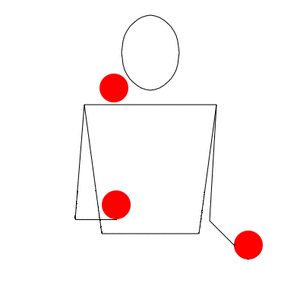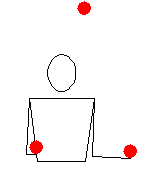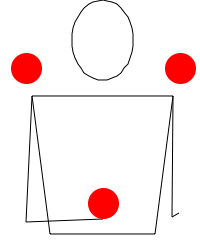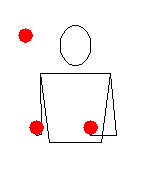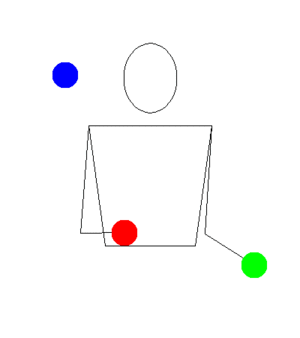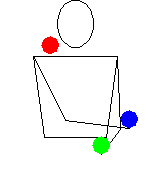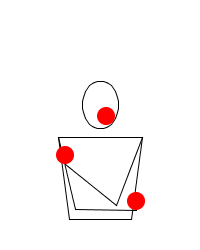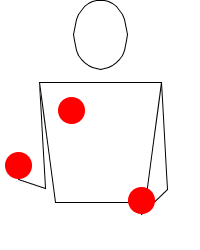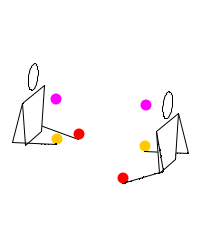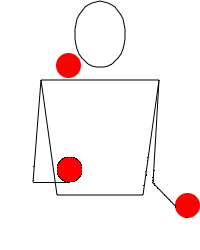Juggling pattern facts for kids
A juggling pattern or juggling trick is a special way to move things like balls, rings, or clubs when you are juggling. Think of juggling as a fun way to combine cool movements with your body and mind.
Most juggling patterns are used in toss juggling. This is where you throw and catch objects in a repeating sequence. Some patterns are simple, like the cascade. Others are more complex, like the Mills mess. A juggling trick is a single special throw or catch. This could be a very high throw or catching a ball behind your neck. Jugglers use special codes called siteswap notation to write down patterns and tricks.
Cool Juggling Patterns
There are so many different juggling patterns! Most patterns use three or more objects. These objects can be balls, rings, or clubs. The most common patterns in toss juggling are the cascade, the shower, and the fountain.
The Cascade Pattern
The cascade is often the first pattern jugglers learn. It's a smooth, symmetrical pattern. You use an odd number of objects, usually three or more. Each hand throws an object in an arching path to the opposite hand. You catch the objects on the outside of your throws. If you catch them on the inside, it's called a reverse cascade.
Many tricks mix cascade and reverse cascade throws. For example, in a pattern called tennis, one ball is thrown in a reverse cascade style. The other two are thrown in a regular cascade style.
The Shower Pattern
You can do the shower pattern with two or more objects. In this pattern, the objects follow a circular path. One hand throws objects high in an arc to the other hand. The other hand throws objects in a flatter, more horizontal path. You can do showers clockwise or counter-clockwise.
The Half Shower Pattern
A half shower pattern is similar to the shower. In this pattern, both hands throw objects in arching, cascade-like paths. But the objects from one hand always go above the objects from the other hand. You can do this pattern with three or more objects. With more objects, you can even vary the heights of the throws.
The Fountain Pattern
The fountain pattern uses an even number of objects, usually four or more. It's a symmetrical pattern. Each hand juggles half of the objects by itself. This means each hand throws objects only to itself. A fountain where you throw objects to the outside is called a reverse fountain. If only one hand juggles, it's called n in one hand, where 'n' is the number of objects. Unlike the cascade, you can do fountains with both hands throwing at the same time (synchronously) or one after the other (asynchronously).
The Columns Pattern
In a columns pattern, the objects go straight up and down. You can do this pattern with two or more objects. A simple version uses two balls in one hand. With three objects, you throw them in three separate vertical lines. The two outside objects are thrown at the same time. The middle object is thrown when the other two are caught.
The Box Pattern
Box patterns mix vertical throws (like columns) with horizontal throws (like the shower). The objects seem to trace the shape of a box in the air. You can do box patterns with two or more objects. They can be done with both hands throwing at the same time (synchronously) or one after the other (asynchronously).
The Half-Box Pattern
The half-box is a pattern that looks like a mix of the box and juggling two objects in one hand. It's a bit tricky but very cool to learn.
The Mills Mess Pattern
The Mills mess is a famous pattern named after Steve Mills. You can do it with three or more objects. In this pattern, your arms cross over each other as you throw the objects. If you use an odd number of objects, each throw goes from one hand to the other. If you use an even number, each hand juggles its own objects. So, it's like a cascade or fountain, but with cool arm movements!
The 423 Pattern
There are many tricks based on the "423" siteswap. These include the plain 423, Takeouts, the Fake Mess, and Burke's barrage. The numbers in siteswap tell you how high and where to throw the balls. For example, a "4" might mean a high throw, and a "2" might mean you hold a ball.
Burke's Barrage
Burke's barrage is a very popular juggling pattern. It's named after its inventor, Ken Burke. Jugglers love it because of the impressive arm movements. It looks hard, but it's not as difficult as some other patterns. In this pattern, you often throw a ball while your arms are crossed. You might also catch a ball using a special grip called the claw.
Rubenstein's Revenge
Rubenstein's revenge is a challenging 3-ball pattern. It's named after Rick Rubenstein. This pattern, along with Mills Mess and Burke's barrage, is one of the most famous patterns that involve complex arm movements and crossed throws. Many jugglers consider Rubenstein's revenge to be the most difficult of the three.
The Windmill Pattern
A windmill pattern, also called a false shower, looks a lot like the shower. It's often learned before or after the Mills Mess. In a windmill, one hand throws objects in an outside (reverse cascade) path. The other hand throws objects underarm. This makes the outside hand cross over the underarm hand to catch.
Passing Juggling
Passing juggling is when two or more jugglers throw objects to each other. Siteswap notation can also describe passing patterns. The letter 'p' is used to show a passing throw. For example, in the "Four-count" pattern, every fourth throw is a pass to another juggler.
Multiplex Patterns
In multiplex patterns, you catch or throw two or more objects with just one hand! If you throw two objects at once, it's called a duplex. If you throw three, it's a triplex. Multiplex throws are usually divided into two types: stacked multiplex and split multiplex.
Stacked Multiplex
Stacked multiplex throws mean you throw two or more objects from one hand and catch them in the same hand. The objects usually fly through the air one above the other. This means you catch them one after another. Sometimes, if the objects are far enough apart, you can catch and throw them separately again. This is called a cut.
Split Multiplex
As the name suggests, split multiplex throws involve throwing two or more objects from one hand and "splitting" them in the air. This way, each hand can catch one or more objects. Some objects might fly at the same height and be caught at the same time. Others might be at different heights and caught one after another, similar to a 'cut' stacked throw.
Juggling Diagrams


